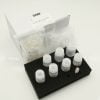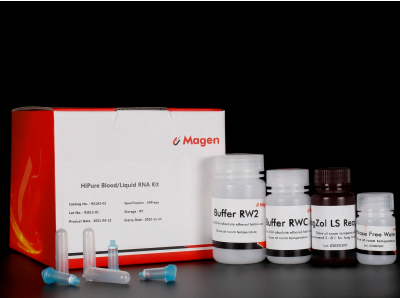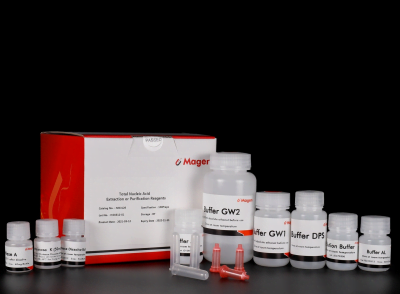- Componentes del kit de reactivos
| Especificaciones | 50t | 100t |
| Gato. No. | SN0329 | SN0330 |
| Columnas de limpieza de ADN (colocar) | 50 (colocar) | 100 (colocar) |
| Columnas de extracción de ARN (colocar) | 50 (colocar) | 100 (colocar) |
| Extracción de ARN Buffer I | 30 ml | 2×30 ml |
| RNA Extraction Buffer IV | 30 ml | 2×30 ml |
| Tampón de eliminación de inhibidores | 2×30 ml | 4×30 ml |
| Tampón de lavado 1 | 2×15 ml | 3×15 ml |
| Tampón de elución | 20 ml | 20 ml |
| Proteinasa K | 1ml | 2x1ml |
| Manual de instrucciones | 1 | 1 |
- Almacenamiento
Este kit de reactivos debe almacenarse a temperatura ambiente. (15-25℃) in a dry condition and is stable for 12 meses. Proteinase K contains a stabilizer, allowing it to be transported at room temperature; sin embargo, for long-term storage, debe mantenerse a -20 ℃.
- Instrucciones para usar el kit de reactivos
3.1 Este kit está destinado a fines de investigación de biología molecular y no debe utilizarse para el diagnóstico o tratamiento de enfermedades..
3.2 Algunos componentes del kit contienen irritantes.; es recomendable tomar las precauciones necesarias (como usar ropa y gafas protectoras).
3.3 El uso de este kit requiere equipo adicional como una centrífuga de alta velocidad., baño de agua (baño de metal), mezclador Vortex, etanol anhidro, nitrógeno líquido, cloroformo, agua desionizada estéril, y tubos EP.
- Introducción al kit de reactivos
The sample DNA/RNA simultaneous isolation and purification kit provide a fast and efficient purification solution for tissue sample DNA/RNA. This kit offers two sets of lysis systems, suitable for various sample tissues and cells, including most plants, animales, bacterias, etc..
The DNA/RNA rapid purification kit can extract total DNA/RNA from samples within 1 hora. The extracted DNA/RNA can be directly used for RT-PCR, transferencia Northern, etc.. Todo el proceso de purificación no requiere reactivos tóxicos como el fenol-cloroformo..
- Principios y procedimientos experimentales

- Proceso de extracción
Precauciones antes de comenzar el experimento.:
A. Antes de usar, add the specified amount of absolute ethanol to LavarBuffer 1 according to the label on the reagent bottle, and mark a check on the label to indicate the addition of absolute ethanol.
B. El tampón de elución es un 0.1x solución TE with a minimal amount of EDTA. Si EDTA tiene un impacto en los experimentos posteriores, Se recomienda usar agua desionizada estéril como sustituto del tampón de elución.
C. RNA Extraction Buffer I is designed for the extraction of plant and fungal samples, while RNA Extraction Buffer IV is primarily used for animal tissues, sangre, and other sample tissues.
- Procesamiento de muestras:
- Plant/animal tissue materials: Collect samples using liquid nitrogen, grind the collected material directly in liquid nitrogen, and proceed to step 2 (recommended to use RNA Extraction Buffer I).
- Cell tissues: Centrifuge and collect <107 suspended cells in a 1.5 Ml tubo de centrífuga, quickly proceed to step 2 (recommended to use RNA Extraction Buffer III).
- Agregar 500μl RNA Extraction Buffer I/RNA Extraction Buffer IV, 10μl proteinasa k, vortex and mix thoroughly. Ensure gentle mixing in this step to prevent mechanical cutting of tissue DNA and reduce DNA yield.
- Transfer the lysate to a purificación de ADN columna, centrifugar en 13,000 rpm para 2 minutos, collect the filtrate (RNA is present in the filtrate). En este punto, DNA is adsorbed on the DNA column and can be briefly stored at 4°C while simultaneously collecting RNA in the next steps.
(Nota: If the sample is plant tissue, centrifugar en 13,000 rpm para 10 minutos, and add the supernatant to the DNA binding column.)
- Precisely estimate the volume of the filtrate, agregar 5 times thevolume of absolute ethanol, mezclar bien. Si se produce la precipitación, it does not affect subsequent experiments.
- Add the obtained liquid to the RNA extraction purification column (Aproximadamente 650-700 μl cada vez), centrifugar a más 8,000 rpm para 1 minuto, Deseche el líquido de desechos recolectados, y vuelva a insertar el tubo de recolección en la columna de purificación para el siguiente paso.
- Repita el paso 5, add the remaining liquid to the RNA extraction purification column, centrifugar a más 8,000 rpm para 1 minuto, discard the waste liquid and collection tube, place the RNA extraction purification column in a new collection tube, and prepare for simultaneous collection of DNA.
- Agregar 600μl Inhibitor Removal Buffer to the DNA extraction purification column and RNA extraction purification column, centrifugar a más 8,000 rpm para 1 minuto, Deseche el líquido de desechos, and reinsert the DNA/RNA purification column into the collection tube for the next step.
- Agregar 700μl Wash Buffer 1 to the DNA extraction purification column and RNA extraction purification column, centrifugar en 14,000 rpm (20,000×g) para 2 minutos. Extend centrifugation time appropriately to ensure the membrane is thoroughly dried.
(Nota: Confirm that absolute ethanol has been added to Wash Buffer 1. The presence of ethanol has a significant impact on subsequent experiments, so membrane drying is crucial. Después de la centrifugación, ensure no ethanol is present before elution, then discard the waste liquid and collection tube.
After washing with Wash Buffer 1, the membrane of the RNA purification column should only have a slight color. Después de la centrifugación, Retire con cuidado la columna de purificación de ARN., ensuring no contact with the collection tube to avoid ethanol interference.)
- Place the DNA/RNA purification column into a new centrifuge tube, drip 50-100 μl Elution Buffer onto the membrane, incubar a temperatura ambiente durante 5 minutos (15°C-25°C), centrifugar a más 8,000 rpm para 1 minuto.
(Nota: Eluting nucleic acids with 50 μl Elution Buffer can increase the nucleic acid concentration but decrease the total nucleic acid yield.)
- Nota:
- Generalmente, larger elution volumes result in higher elution efficiency, but to increase nucleic acid concentration, the elution volume can be reduced, but not below 50 µl.
- ARN, in the presence of RNA Extraction Buffer I/RNA Extraction Buffer III, is not degraded by RNAse but should be distinguished from DNA in subsequent experiments. Use RNAse-free consumables for RNA separation whenever possible.












Reseñas
Aún no hay reseñas.